Development of an Automated Phase-Shifting Interferometer Using a Homemade Liquid-Crystal Phase Shifter
Abstract
1. Introduction
2. Phase-Shifting Interferometry Principles and Algorithms
2.1. The Principle of Phase-Shifting Interferometry
2.1.1. Dual-Beam Interferometry
2.1.2. Four-Step Phase-Shifting Method
2.2. Phase Unwrapping
3. Experiment Setup
3.1. Measurement System
3.2. Automated Image Acquisition System
3.2.1. Square-Wave Generation
3.2.2. Communication Interface
3.3. Fabrication and Control Method of the Liquid-Crystal Tunable Waveplate
3.4. Characterization of Custom Liquid-Crystal Phase Shifter
3.5. Interference Pattern Acquisition
4. Experimental Results
4.1. Phase-Distribution Reconstruction of Test Lens
4.2. Phase Characterization of Custom Liquid-Crystal Grating
5. Discussion
5.1. Analysis of Driving Voltage and Phase-Shift Resolution in Liquid-Crystal Phase Shifters
5.2. Cost Analysis
5.3. Application Scope and Improvement Directions
6. Conclusions
Author Contributions
Funding
Data Availability Statement
Conflicts of Interest
References
- Shen, C.Y.; Li, J.; Mengu, D.; Ozcan, A. Multispectral quantitative phase imaging using a diffractive optical network. Adv. Intell. Syst. 2023, 5, 2300300. [Google Scholar] [CrossRef]
- Goodman, J.W. Introduction to Fourier Optics, 3rd ed.; Roberts and Company Publishers: Greenwood Village, CO, USA, 2005. [Google Scholar]
- Zhang, Q.; Lu, S.; Li, J.; Li, D.; Lu, X.; Zhong, L.; Tian, J. Phase-shifting interferometry from single frame in-line interferogram using deep learning phase-shifting technology. Opt. Commun. 2021, 498, 127226. [Google Scholar] [CrossRef]
- Cheng, Y.-Y.; Wyant, J.C. Phase shifter calibration in phase-shifting interferometry. Appl. Opt. 1985, 24, 3049–3052. [Google Scholar] [CrossRef] [PubMed]
- Kreis, T. Digital Holographic Interferometry. In Digital Holography and Digital Image Processing; Springer: Dordrecht, The Netherlands, 2005. [Google Scholar]
- Creath, K. Phase-shifting speckle interferometry. Appl. Opt. 1985, 24, 3053–3058. [Google Scholar] [CrossRef] [PubMed]
- Zhang, Y.; Tian, X.; Liang, R. Accurate and fast two-step phase shifting algorithm based on principle component analysis and Lissajous ellipse fitting with random phase shift and no pre-filtering. Opt. Express 2019, 27, 20047–20063. [Google Scholar] [CrossRef] [PubMed]
- Machuca-Bautista, Y.B.; Strojnik, M.; Flores, J.L.; Serrano-García, D.I.; García-Torales, G. Michelson interferometer for phase shifting interferometry with a liquid crystal retarder. Results Opt. 2021, 5, 100197. [Google Scholar] [CrossRef]
- Cai, D.; Xue, L.; Ning, L. Characteristics of phase-only liquid crystal spatial light modulator. Opt.-Electron. Eng. 2007, 34, 19–23. [Google Scholar]
- Xia, H.; Montresor, S.; Guo, R.; Li, J.; Yan, F.; Cheng, H.; Picart, P. Phase calibration unwrapping algorithm for phase data corrupted by strong decorrelation speckle noise. Opt. Express 2016, 24, 28713–28730. [Google Scholar] [CrossRef] [PubMed]
- Morris, M.N.; Millerd, J.; Brock, N.; Hayes, J.; Saif, B.; Stahl, H.P. Dynamic phase-shifting electronic speckle pattern interferometer. In Proceedings of the Optical Manufacturing and Testing VI, San Diego, CA, USA, 31 July–4 August 2005; SPIE: Bellingham, WA, USA, 2005; Volume 5869, p. 58690P. [Google Scholar]
- Bai, F.; Lang, J.; Gao, X.; Zhang, Y.; Cai, J.; Wang, J. Phase shifting approaches and multi-channel interferograms position registration for simultaneous phase-shifting interferometry: A review. Photonics 2023, 10, 946. [Google Scholar] [CrossRef]
- Millerd, J.; Brock, N.; Hayes, J.; Kimbrough, B.; Novak, M.; North-Morris, M.; Wyant, J.C. Modern Approaches in Phase Measuring Metrology. In Proceedings of the Optical Measurement Systems for Industrial Inspection IV, Optical Sciences Center, University of Arizona, Tucson, AZ, USA, 13–17 June 2005; SPIE: Bellingham, WA, USA, 2005; Volume 5856, pp. 14–22. [Google Scholar]
- Li, W.-Z.; Zhou, Z.-Y.; Chen, L.; Li, Y.-H.; Guo, G.-C.; Shi, B.-S. Creating multibeam interference from two-beam interference with cascading and recycling harmonics generation. Phys. Rev. Res. 2025, 7, 023208. [Google Scholar] [CrossRef]
- Flores, J.L.; Ayubi, G.A.; Di Martino, J.M.; Castillo, O.E.; Ferrari, J.A. 3D-shape of objects with straight line-motion by simultaneous projection of color coded patterns. Opt. Commun. 2018, 414, 185–190. [Google Scholar] [CrossRef]
- Zhu, Y.; Tian, A. Influence of phase-shifting error of phase-shifting interferometry on the phase accuracy recovery. J. Opt. 2024, 53, 363–382. [Google Scholar] [CrossRef]
- Xia, H.; Montresor, S.; Picart, P.; Guo, R.; Li, J. Comparative analysis for combination of unwrapping and de-noising of phase data with high speckle decorrelation noise. Opt. Lasers Eng. 2018, 107, 71–77. [Google Scholar] [CrossRef]
- Zuo, C.; Huang, L.; Zhang, M.; Chen, Q.; Asundi, A. Temporal phase unwrapping algorithms for fringe projection profilometry: A comparative review. Opt. Lasers Eng. 2016, 85, 84–103. [Google Scholar] [CrossRef]
- Ye, Y.D.; Yan, H.; Wang, F.; Li, J.-M. Phase compensation with rotating quarter waveplate in polarizing beam splitting scheme of laser launched and received in common aperture. High Power Laser Part. Beams 2006, 18, 749–752. [Google Scholar]
- Muravsky, L.; Ostash, O.; Voronyak, T.; Andreiko, I. Two-frame phase-shifting interferometry for retrieval of smooth surface and its displacements. Opt. Laser Eng. 2011, 49, 305–312. [Google Scholar] [CrossRef]
- Usman, A.; Bhatranand, A.; Jiraraksopakun, Y.; Kaewon, R.; Pawong, C. Real-time double-layer thin film thickness measurements using modified Signac interferometer with polarization phase shifting approach. Photonics 2021, 8, 529. [Google Scholar] [CrossRef]
- Ciddor, P.E. Refractive index of air: New equations for the visible and near infrared. Appl. Opt. 1996, 35, 1566–1573. [Google Scholar] [CrossRef] [PubMed]
- Copland, J.; Neal, D.R.; Neal, D.A. Shack-Hartmann Wavefront Sensor Precision and Accuracy. In SPIE 4779, Proceedings of the Advanced Characterization Techniques for Optical, Semiconductor, and Data Storage Components, Seattle, WA, USA, 11 November 2002; SPIE: Bellingham, WA, USA, 2002. [Google Scholar]
- Hao, Q.; Liu, Y.; Hu, Y.; Tao, X. Measurement techniques for aspheric surface parameters. Light Adv. Manuf. 2023, 4, 27. [Google Scholar] [CrossRef]
- Zhang, Z.; Dong, F.; Qian, K.; Zhang, Q.; Chu, W.; Zhang, Y.; Man, X.; Wu, X. Real-time phase measurement of optical vortices based on pixelated micropolarizer array. Opt. Express 2015, 23, 20521–20528. [Google Scholar] [CrossRef] [PubMed]
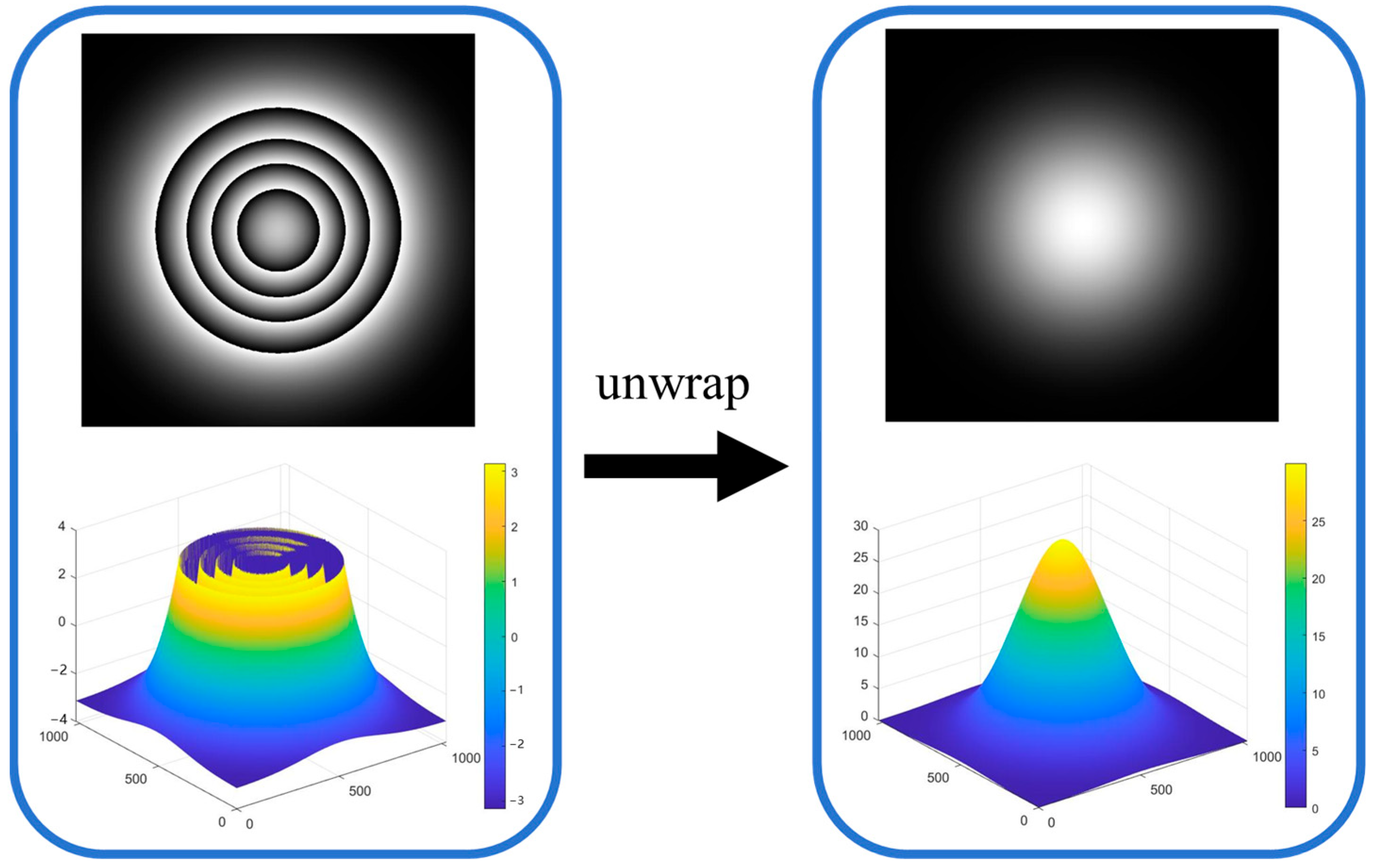
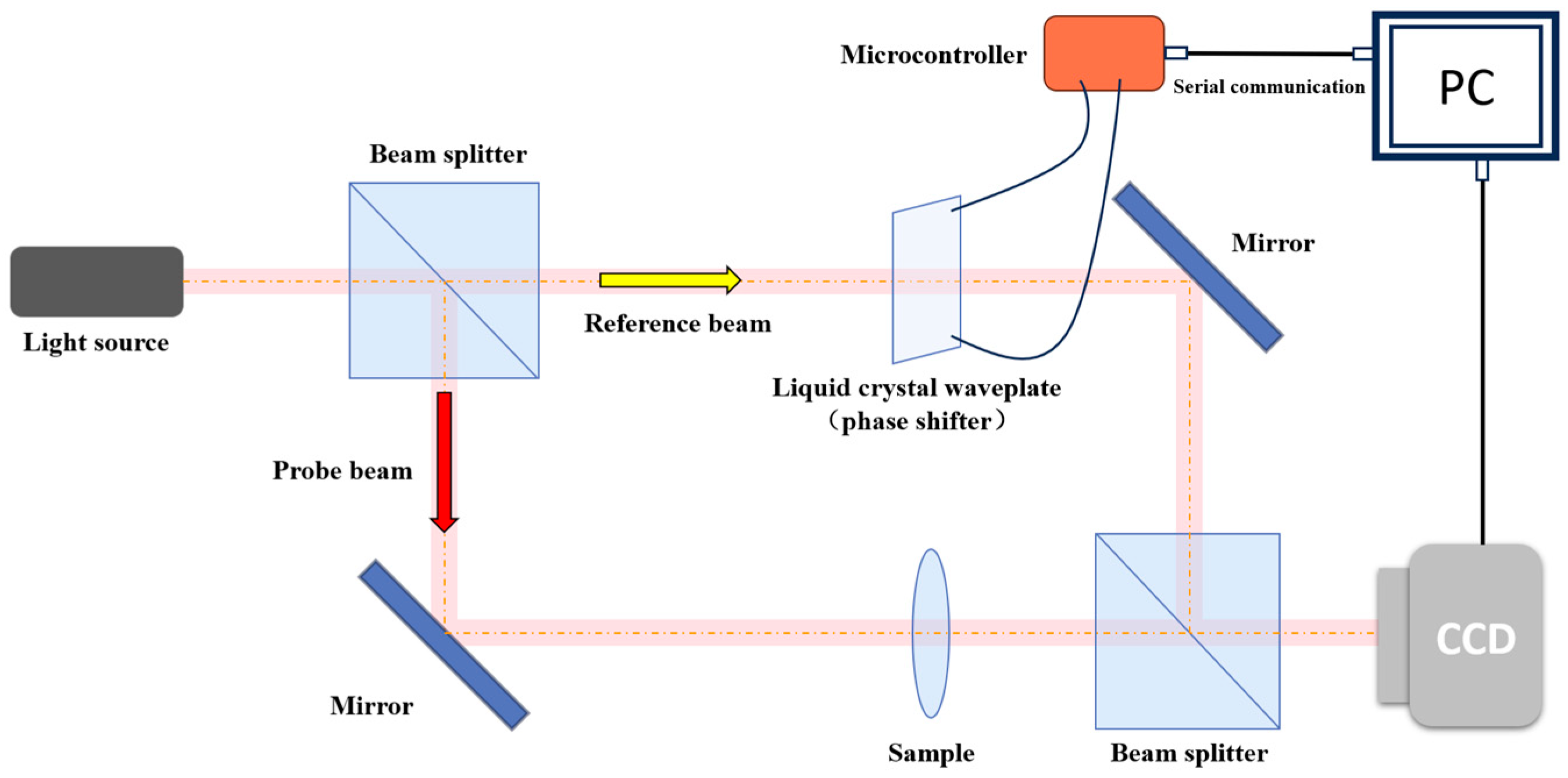
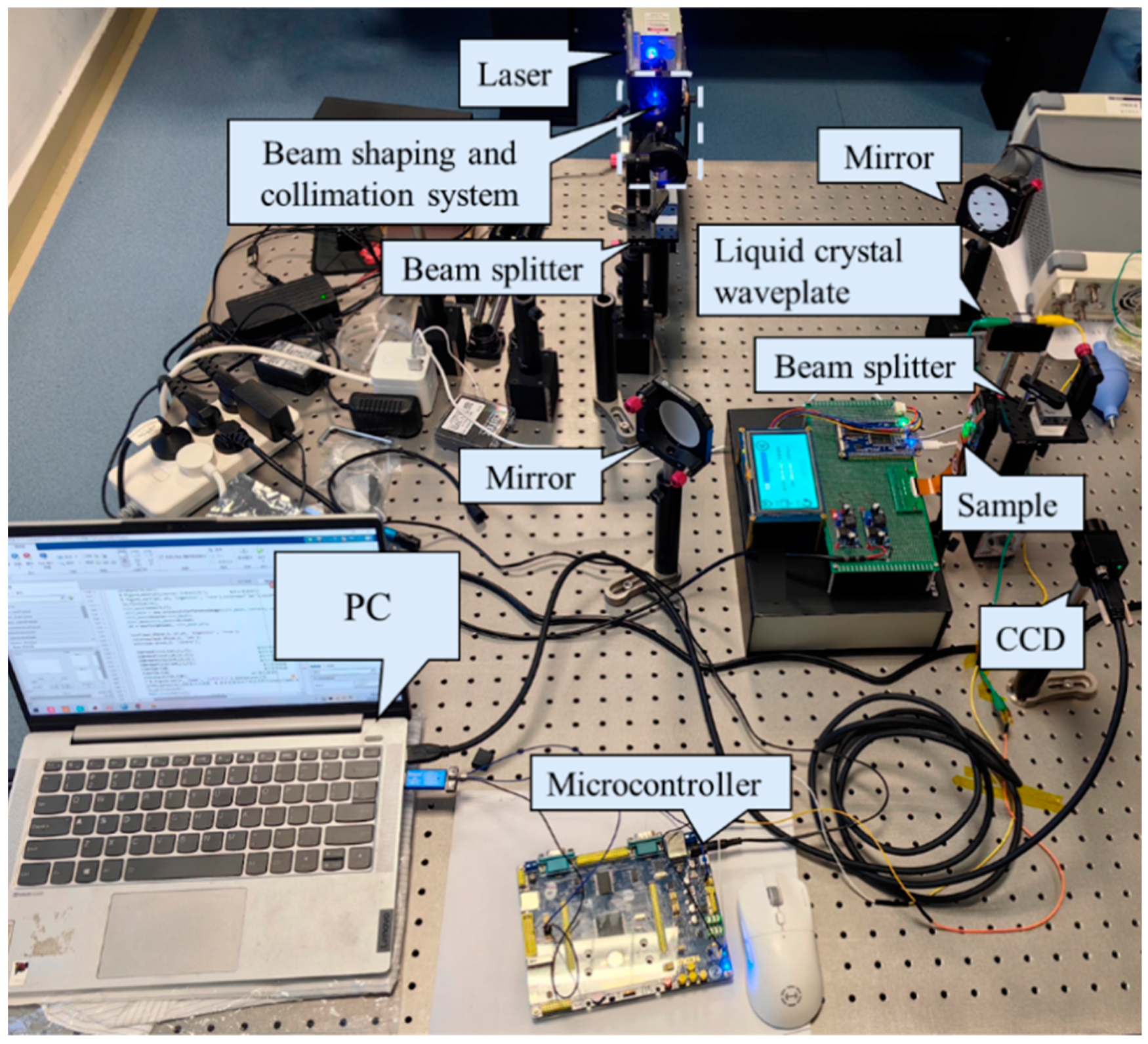
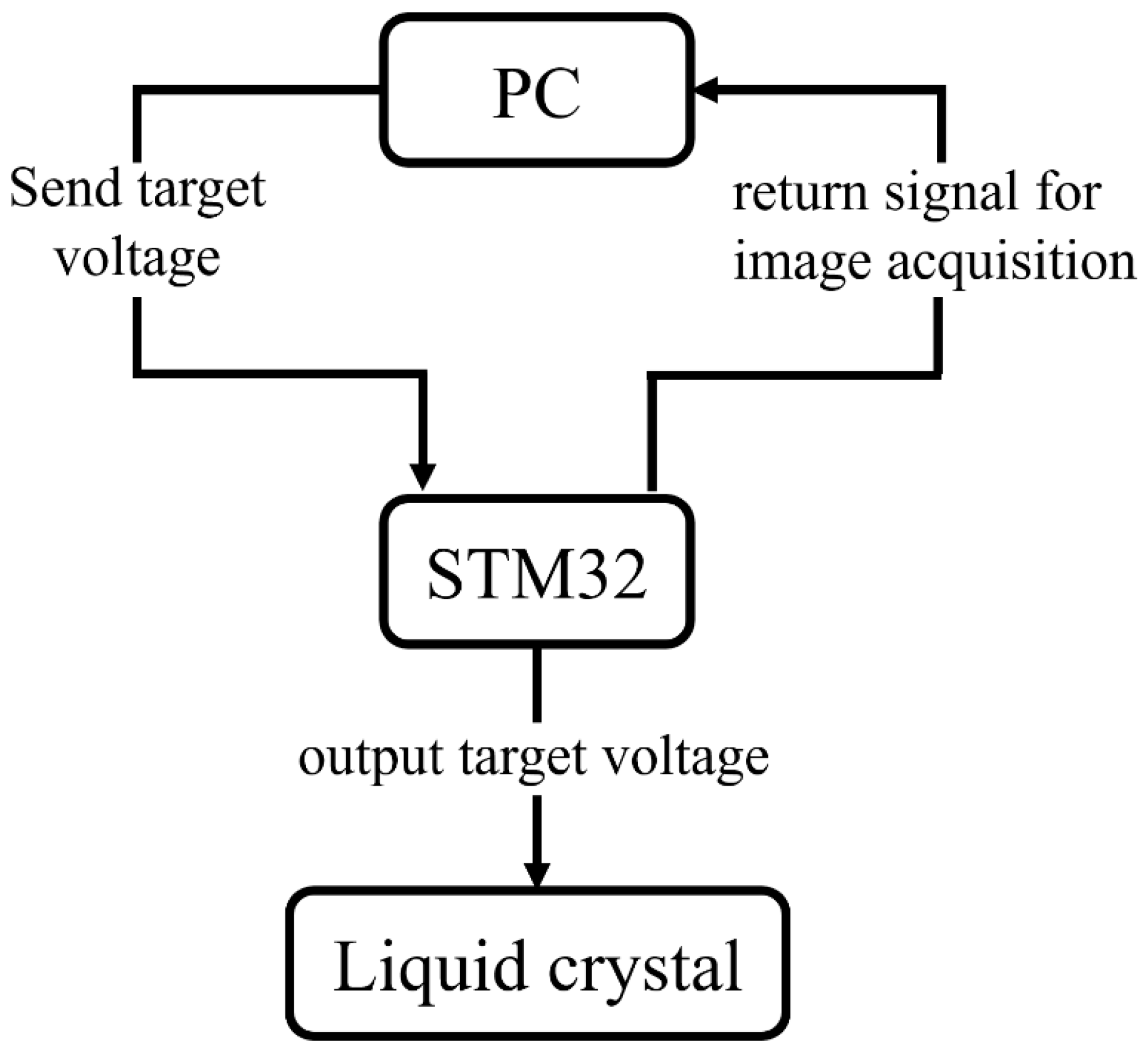
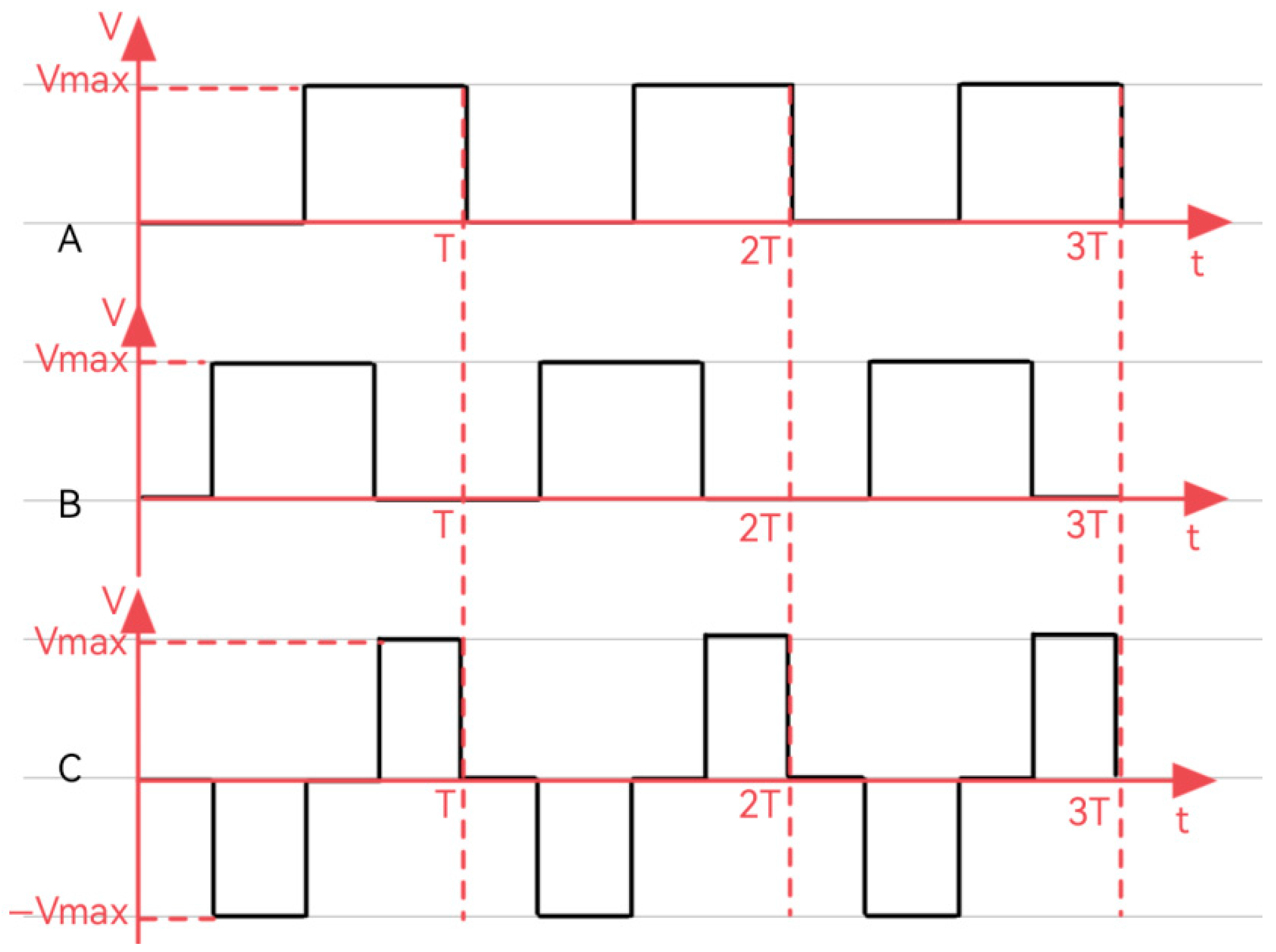

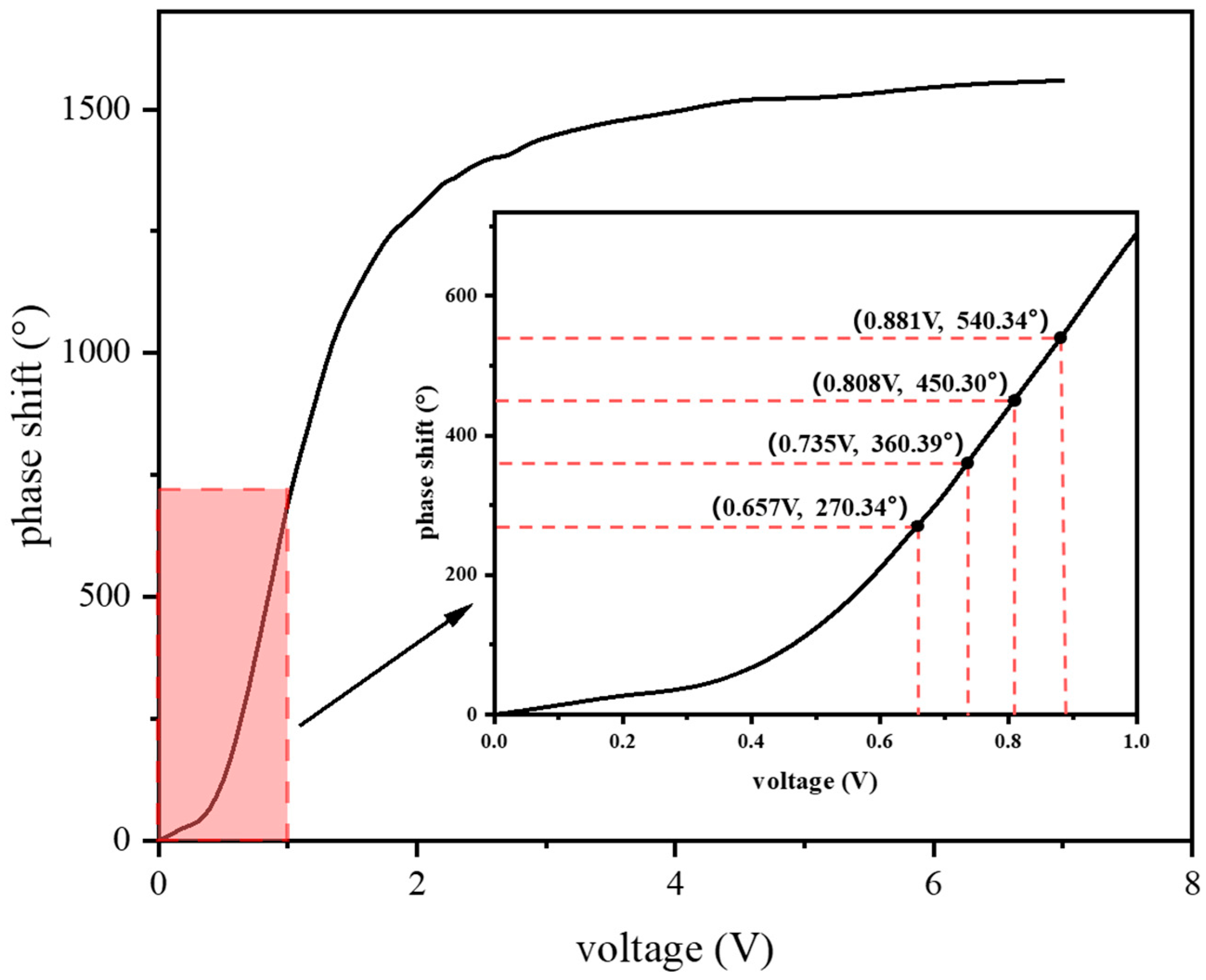
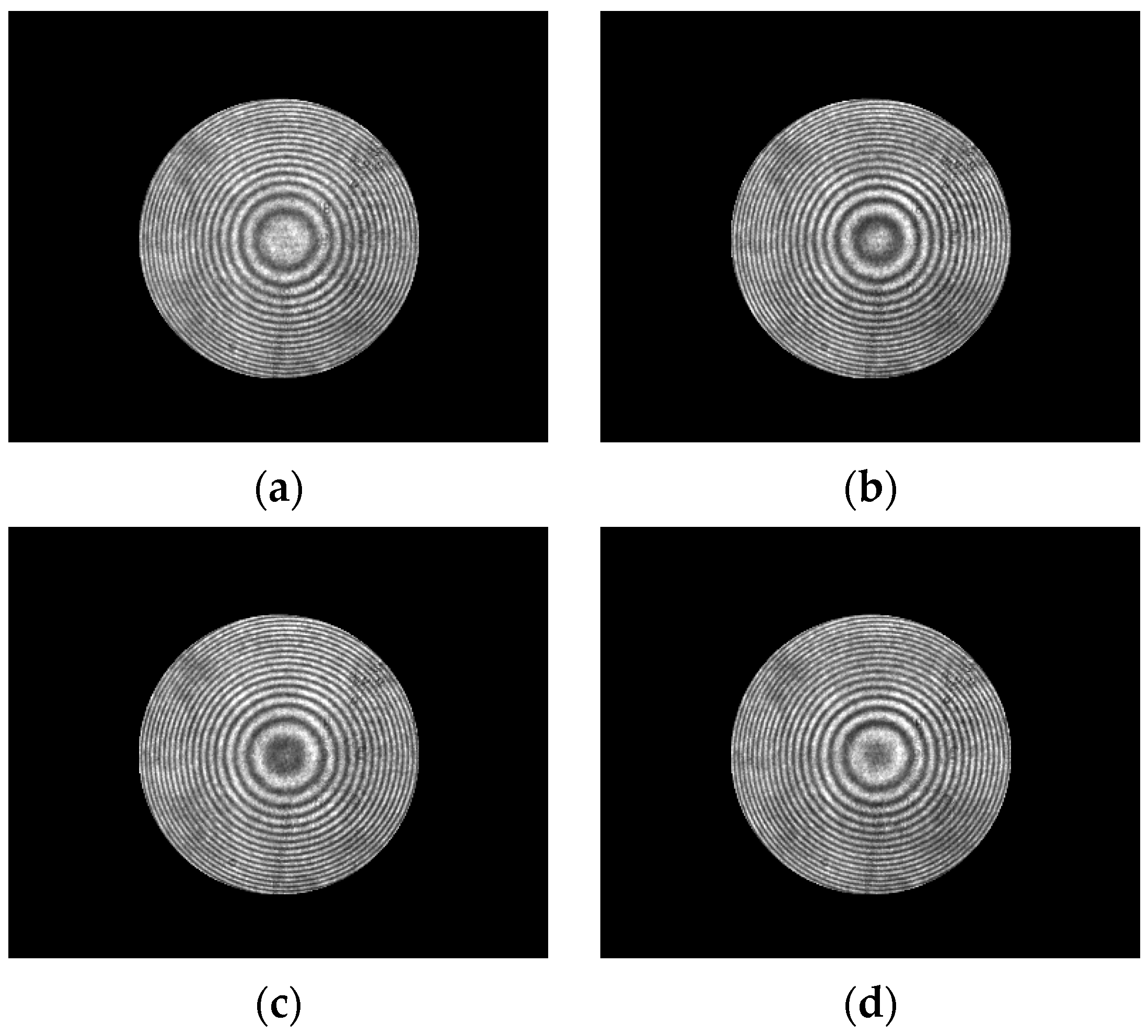
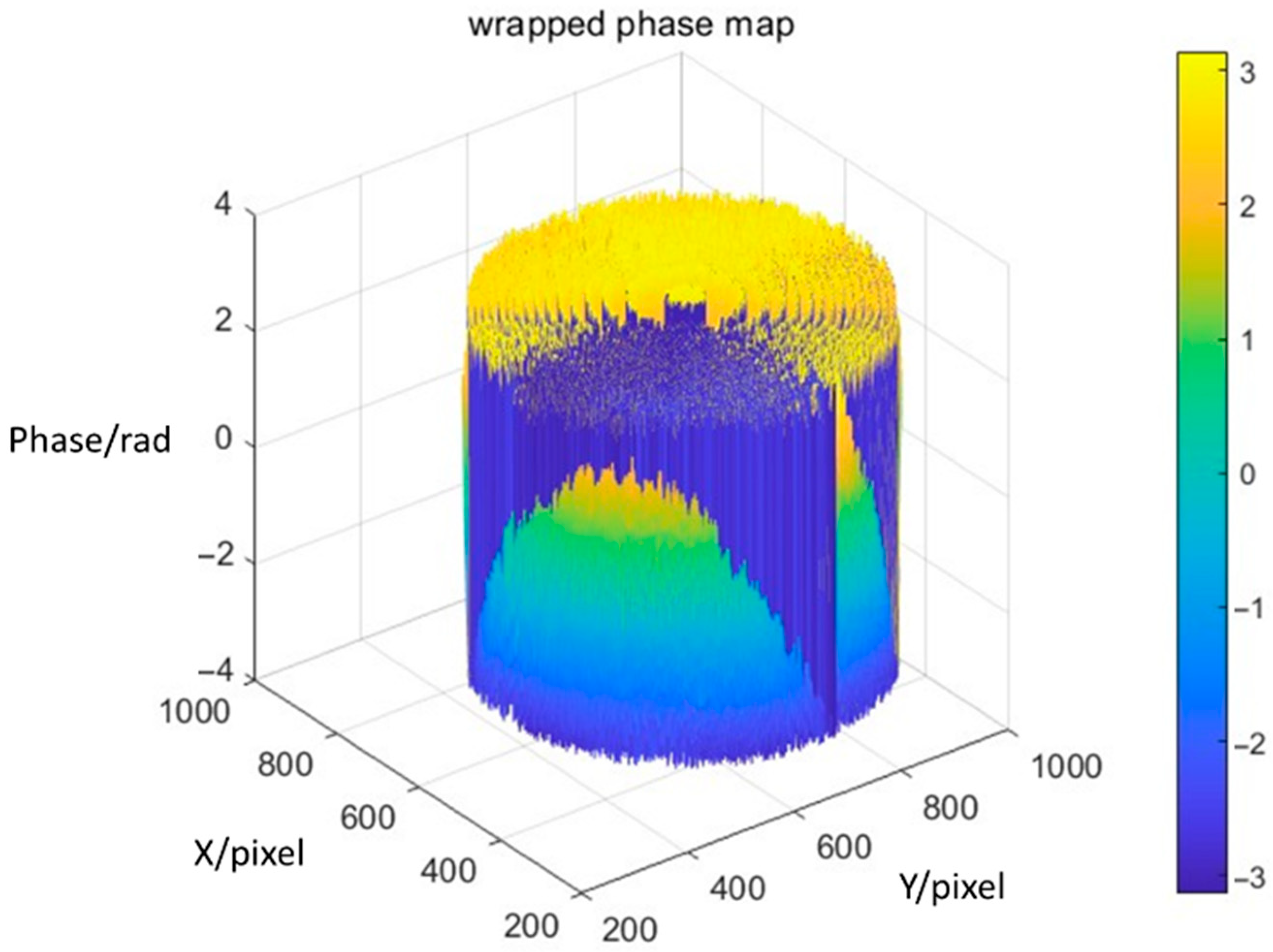
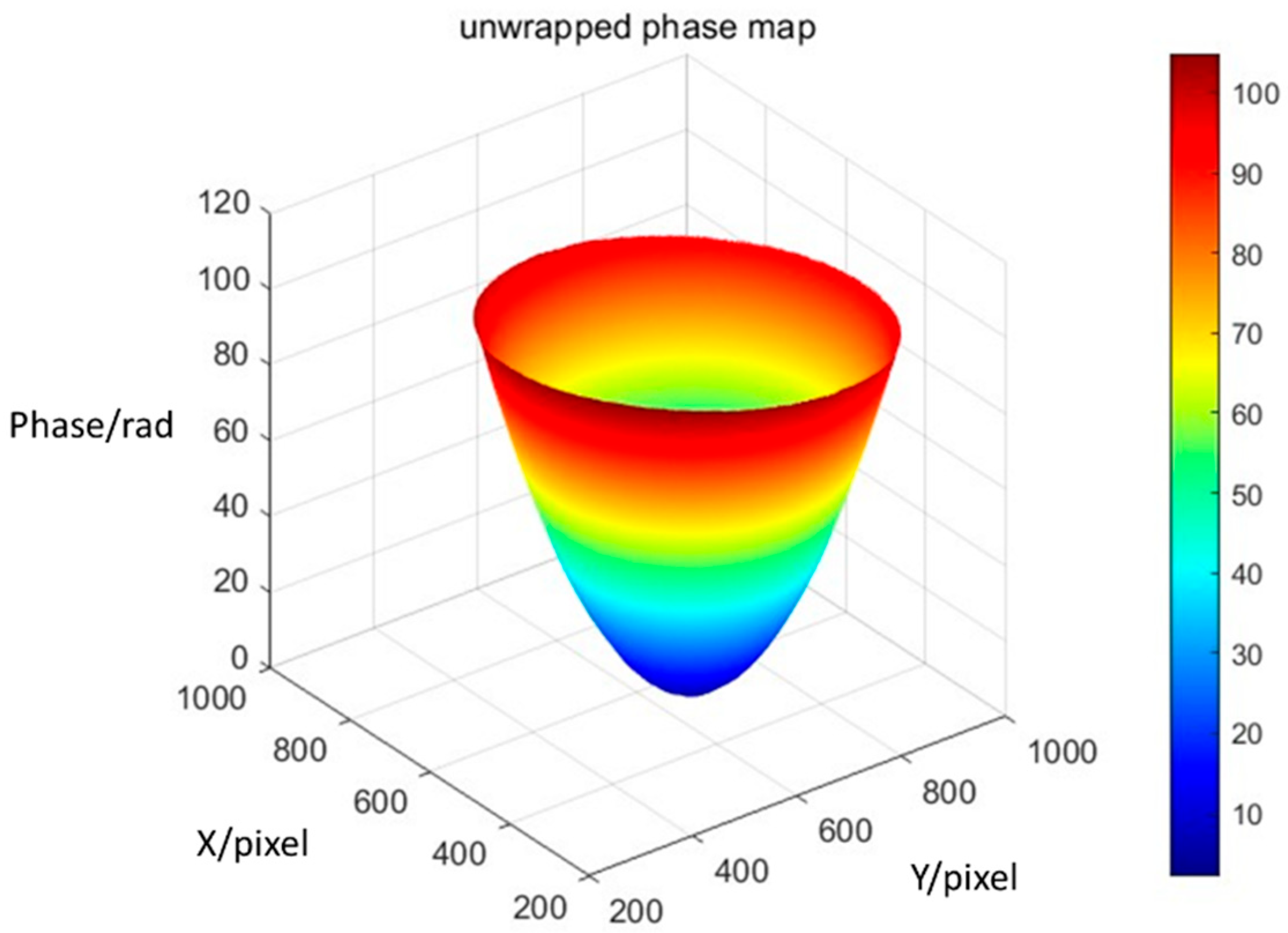
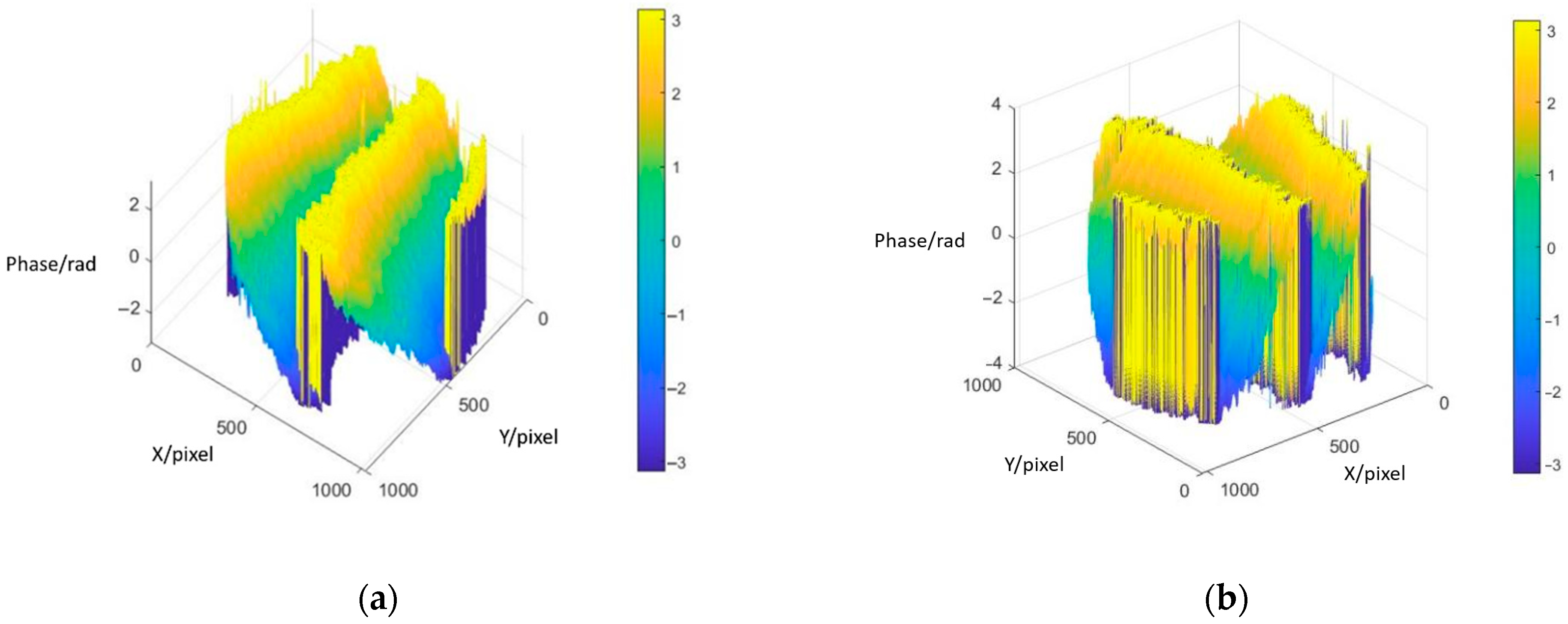

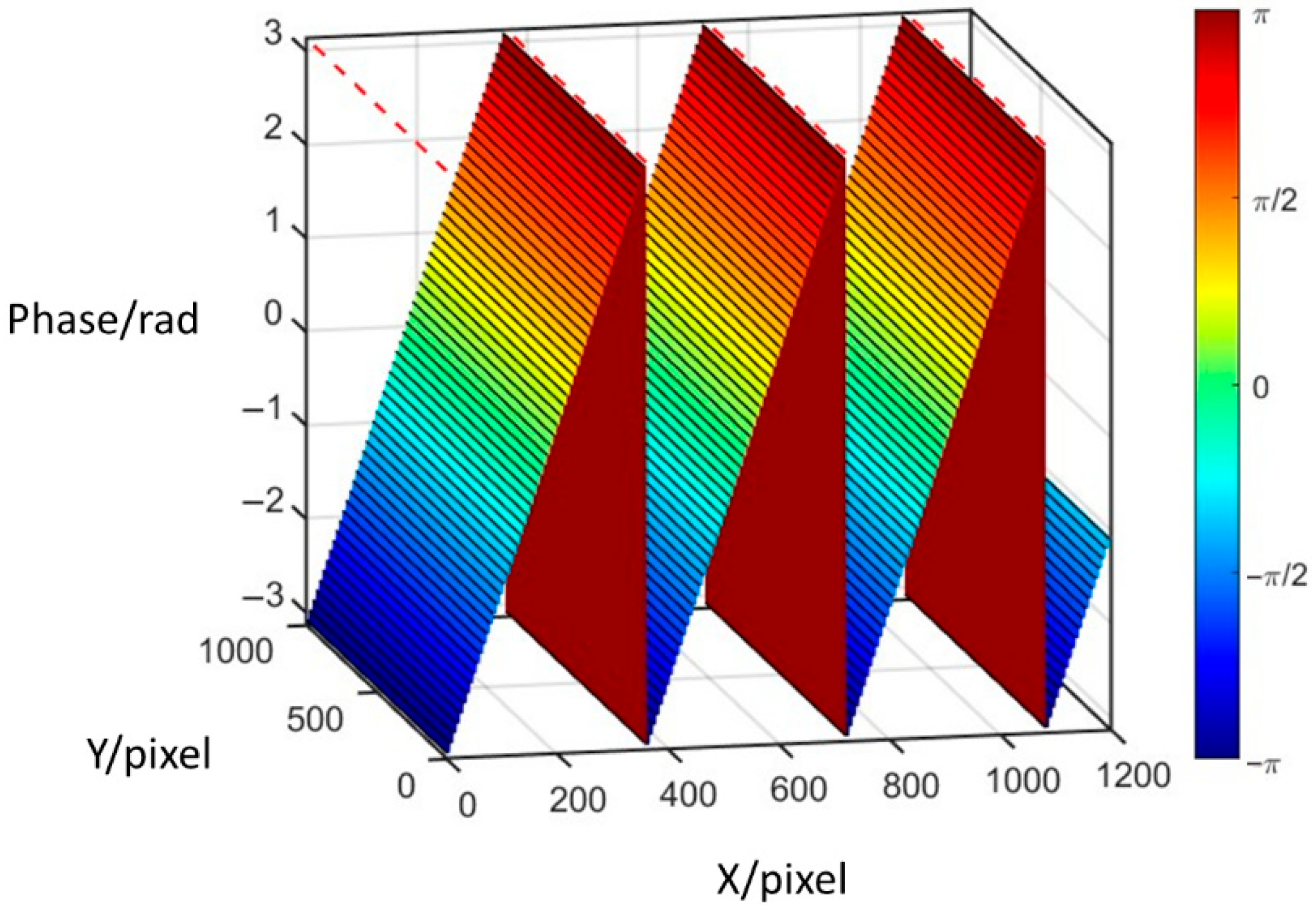
Disclaimer/Publisher’s Note: The statements, opinions and data contained in all publications are solely those of the individual author(s) and contributor(s) and not of MDPI and/or the editor(s). MDPI and/or the editor(s) disclaim responsibility for any injury to people or property resulting from any ideas, methods, instructions or products referred to in the content. |
© 2025 by the authors. Licensee MDPI, Basel, Switzerland. This article is an open access article distributed under the terms and conditions of the Creative Commons Attribution (CC BY) license (https://creativecommons.org/licenses/by/4.0/).
Share and Cite
Song, Z.; Xu, L.; Wang, J.; Liang, X.; Dai, J. Development of an Automated Phase-Shifting Interferometer Using a Homemade Liquid-Crystal Phase Shifter. Photonics 2025, 12, 722. https://doi.org/10.3390/photonics12070722
Song Z, Xu L, Wang J, Liang X, Dai J. Development of an Automated Phase-Shifting Interferometer Using a Homemade Liquid-Crystal Phase Shifter. Photonics. 2025; 12(7):722. https://doi.org/10.3390/photonics12070722
Chicago/Turabian StyleSong, Zhenghao, Lin Xu, Jing Wang, Xitong Liang, and Jun Dai. 2025. "Development of an Automated Phase-Shifting Interferometer Using a Homemade Liquid-Crystal Phase Shifter" Photonics 12, no. 7: 722. https://doi.org/10.3390/photonics12070722
APA StyleSong, Z., Xu, L., Wang, J., Liang, X., & Dai, J. (2025). Development of an Automated Phase-Shifting Interferometer Using a Homemade Liquid-Crystal Phase Shifter. Photonics, 12(7), 722. https://doi.org/10.3390/photonics12070722




